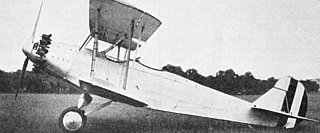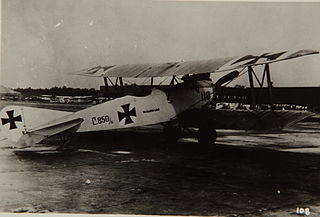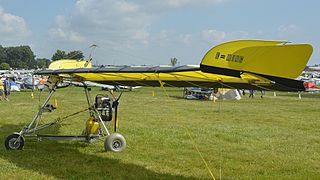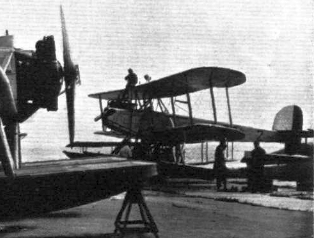
The Albatros L 75 Ass was a German trainer biplane of the 1920s. Of conventional configuration, it seated the pilot and instructor in separate, open cockpits. The wings were single-bay, equal-span, and had a slight stagger. Production continued after Albatros was absorbed by Focke-Wulf.

The Heinkel HD 39 was a special-purpose cargo aircraft developed in Germany in the 1920s to distribute the Berlin newspaper B.Z.. It was a conventional single-bay biplane with staggered wings of equal span, and a fuselage that nearly filled the interplane gap. The pilot sat in an open cockpit, and the undercarriage was of fixed, tailskid type with divided main units. The sole example of the type was built after Ernst Heinkel found out, by chance, that B.Z. required such an aircraft and had ordered two machines from Albatros. Heinkel convinced publisher Ullstein-Verlag to purchase a third aircraft from his firm.

The Keystone K-55 Pronto was a mail plane developed in the United States in the late 1920s. It was a conventional single-bay, unequal-span biplane design with slightly staggered wings. The pilot sat in an open cockpit, in tandem with a second cockpit that could carry two passengers side-by-side. The fixed, tailskid undercarriage had divided main units.
The Parnall Pike was a 2/3-seat biplane reconnaissance aircraft, capable of operating off carrier decks or from water, built to an Air Ministry specification in 1927. Only one was constructed.

[Note, incorrect photo used above!] The Albatros C.II was a 1910s German military pusher reconnaissance biplane designed and built by Albatros Flugzeugwerke. Only one aircraft was built and the type did not enter production.

The Horten H.III was a flying wing sailplane built by Walter and Reimar Horten in Germany from 1937 to 1944.

The Albatros C.IV,. was a German military reconnaissance aircraft built in the autumn of 1915 by Albatros Flugzeugwerke. It was a single-engined biplane, and was based on the Albatros C.III, with which it shared many parts. It was eventually abandoned, in favour of the C.V.

The Cascade Kasperwing I-80 is an American ultralight flying wing motorglider that was designed by Witold Kasper and Steve Grossruck. It was produced by Cascade Ultralites and introduced in 1976. The aircraft was supplied as a kit for amateur construction.

The Albatros L102 / Albatros Al 102, was a German trainer aircraft of the 1930s. It was a parasol-wing landplane, seating the student pilot and instructor in separate, open cockpits. A biplane floatplane version was also built as the Al 102W, with strut-braced lower wings.
The Albatros L 103 / Albatros Al 103 was a German experimental aircraft of the 1930s. It was a parasol-wing landplane of conventional configuration, seating the pilot and flight test observer in separate, open cockpits. The Al 103 was used to test variations in sweepback, dihedral and tailplane area.
The Wier RDW-2 Draggin' Fly was a homebuilt light aircraft, designed in the United States in the 1970s, aimed at fairly inexperienced builders and flyers. Plans were available but only one was built.

The Schoettler I was one of the first aircraft constructed in China, albeit with a German designer. It was a two-seat, single engine biplane, first flown in mid-summer 1923.

The LFG V 60 was a small, single engine, tandem seat floatplane training aircraft, designed and built in Germany in the mid-1920s. About five were constructed.

The Albatros L.71 was a two seat, single pusher engined biplane built in Germany in the 1920s.

The Les Mureaux 3 C.2 and Les Mureaux 4 C.2 were French two seat, parasol winged fighters, flown in 1927-8, which differed only in their engines. They were developed into near identical army co-operation types, the ANF Les Mureaux 130 A.2 and ANF Les Mureaux 131 A.2, in 1929-31.

The Rohrbach Ro VII Robbe was an all-metal, twin engine flying boat built in Germany in the 1920s. It could be adapted to commercial or military rôles.

The Sikorsky S-32 was an American single engine aircraft built by the Sikorsky Manufacturing Corporation in 1926.
The Aerial Service Mercury Senior, Aerial Mercury Senior or just Mercury Senior was a US biplane mailplane designed to operate at night between New York City and Chicago. A different, smaller, lower wing improved its performance for daytime flights. One was built and used by the United States Post Office Department.
The Silesia S-4 was a Polish, low-power parasol wing aircraft built in 1925. After an engine change and airframe modifications it became one of the Silesian Aeroclubs fleet. It was lost in a take-off accident in 1931 and was the last Silesia aircraft to fly.
The Caproni Ca.66 and Caproni Ca.67 were Italian night bomber aircraft designed to re-equip the post-World War I Regia Aeronautica.



















